Google Maps History
- Transfer
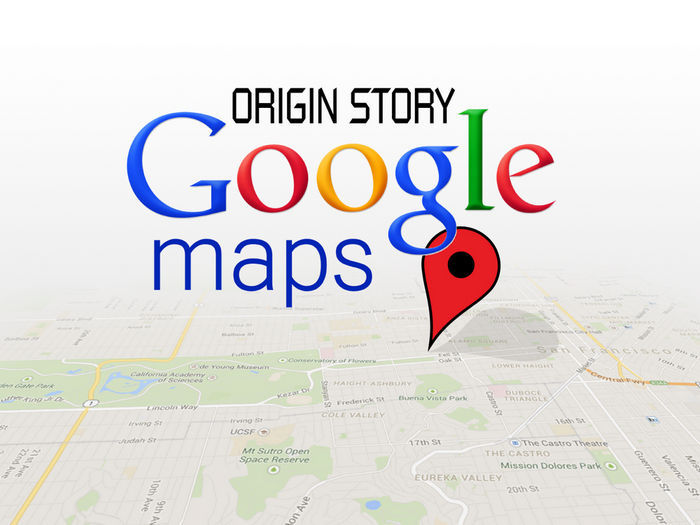
Recently, we wrote that, despite the abundance of existing map services, we had to create our own . Of course, we carefully evaluated the functionality of the systems available at that time on the market. We did not ignore the most popular map service in the world, Google Maps. It turned out that he was 10 years old this year. And we want to pay tribute to this project by making a translation of the story about the history of Google Maps.
When the service was just launched in February 2005, it looked like just a paper atlas, only without the need to turn pages. In contrast to the printable route list, as was done by the then map leader MapQuest, here the routes overlap directly on top of the map. The loading of map image elements took place in a browser, without any special software, so it was possible to explore the world without refreshing the page. It was a breakthrough unprecedented in those days.
In 2005, no one had any idea what the development of online mapping services would lead to, what invaluable value they would play in the Internet ecosystem. No one suggested that Google would enter into a partnership agreement with Apple to promote its service on a mobile platform, but this alliance would break up. It has never occurred to anyone that over one billion people will use Google Maps and the service will turn into the second largest project after the search engine.
Surge in attendance
They were going to open the service for public access the next day. At the same time, the authors of the project planned to leave it in beta status. But one of the users calculated the exact address of the page and published it in one of the sections on the Slashdot forum .
Visitors were extremely surprised by the new, incredible features, including scrolling the map with the mouse cursor. The branch began to quickly fill up with rave reviews. However, users immediately pointed out an important drawback of the service: it contained a map only of the USA, even Canada and Mexico were shown schematically. The rest of the world was ... an endless ocean.

This planetary ocean hinted at Google’s impudent and ridiculous ambitions to create a map of the world. And these ambitions expanded even more after satellite images and street photos were added to the service. In the end, the company got rid of the dictatorship of data providers by breaking direct contracts with countries, states, and even cities around the world.
Virtually useless service
From the very beginning, Google promoted the concept of "place" on the Internet. You may not like the way the company displays some disputed territories, or some interface solutions, but Google Maps has actually formed an idea of modern map services, both in terms of interface and functionality. Although, I must say, Google was not a pioneer. In fact, their service entered the market late; competitors by that time had gone far enough.
It all started in the early 2000s. In September 2003, a product was launched with the sophisticated name “Search by Location,” which was part of the Google Labs pilot project. This service can be considered the first attempt of the company in the field of cartography. It was necessary to enter some kind of keyword, address or zip code, and Google would find sites where this information was mentioned. True, the service was almost useless, according to the developers themselves.
In support of this, an example is given: suppose you had to find coffee shops in Palo Alto. But Sun Microsystems, for example, put its address at the end of each of its web pages, and its product names were associated with coffee (the most famous is Java). And it ruined the whole idea of service. Attendance was zero. Despite the fact that the information from the database was licensed from Yellow Pages, the project did not live up to the expectations of many Google employees, including Larry Page.
Therefore, the company began to look for inspiration and talent on the side. Shortly before Google went public in 2004, three small companies were acquired: Keyhole, Where2 and Zipdash. The first was the largest of them, although the transaction value was never announced. By then, Keyhole had existed for 3 years, consisted of 30 employees, and sold for $ 69.95 a Windows-based application containing satellite imagery. The key idea was that at first the pictures were “glued” to each other to get a solid map of the world, and then it was cut into millions of squares. Therefore, users could start viewing from a large scale, and then “approach” to selected places on the surface of the planet. It was this opportunity that impressed Google’s top management, led by Sergey Brin, so much that they decided to buy Keyhole.
True, this was not easy, the company had enough financial resources to maintain independence. However, the result outweighed the prospect of creating a large-scale mapping service that can be used in a variety of situations. Keyhole management is interested in the opportunity to give a free and powerful tool to many professionals who need accurate and current maps. Also, do not forget that it was April 2003, the United States invaded Iraq, and therefore the use of the map service by the military was discussed.
Barely had time
Where2 Technologies was a small startup that almost went bankrupt shortly before it was acquired by Google. At that time, the vision of map services was formed by the MapQuest project, which, roughly speaking, was a list of directions with small pieces of a map for each turn and intersection. The founders of Where2, the Rasmussen brothers, the Danes, had the idea of creating a full-fledged online map with the ability to move and scale. But no one wanted to buy such a product. As one of the brothers recalls, many believed that an ordinary person would need a card, from strength, several times a week. Today, many people will literally be lost if they do not use online cards several times a day.
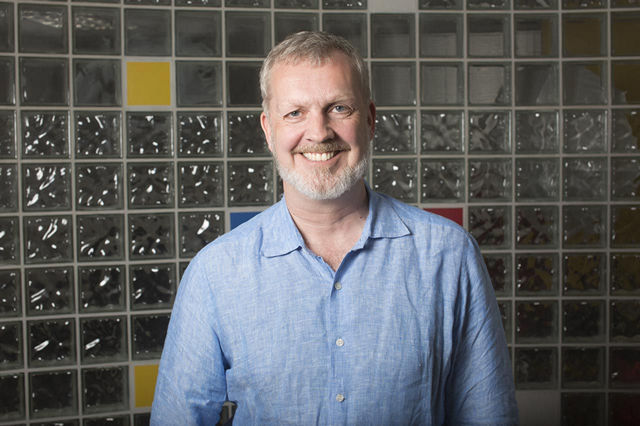
Lars Rasmussen
The situation for Where2 became critical when one of the venture capital investment companies, Sequoia, unexpectedly refused to finance a startup after Yahoo Maps integrated the Yellow Pages database into its service. Information about this quickly spread throughout the market, and the Danes began to refuse everything en masse. It was just at the time the dotcom bubble was blown away.
The brothers were broken. Due to visa restrictions, the company was created by them together with two engineers in Australia, and the startup was doomed without financing. However, the Rasmussen were incredibly lucky. Sequoia introduced them to Larry Page. Google did not yet have its own map service, but Page believed that the future was with the Internet. Therefore, three weeks after they met, Where2 proposed the concept of transforming their application into a web service that loaded data in the background and did not require a page refresh.
«Мы были очень сильно мотивированы, либо пан, либо пропал. В течение трёх недель мы работали день и ночь, и, в результате, создали сайт специально для того, чтобы впечатлить Ларри и его команду», — рассказывает Ларс Расмуссен, который сегодня работает в Facebook. «Мы даже разместили на нём логотип Google. А в качестве маркеров на карте использовали лавовые лампы, потому что они тогда нравились Google».
Любопытно, что в то же самое время команда разработчиков внутри Google реализовывала точно такую же концепцию для первой версии Gmail. Однако они не были знакомы с идеями Where2, и, в результате, создали фундаментальную веб-технологию, которая сегодня известна под названием AJAX.
Третий мушкетёр
In 2004, a small startup Zipdash, consisting of three people (not even a startup at all, because they did not register a legal entity), developed a mobile application to get information about traffic congestion. In fact, the work was just begun, the first version of the product was made for Nextel phones. The founder of Zipdash, Mark Crady, has invested thousands of dollars of his money in licensing information about taxi movements in the vicinity of San Francisco Bay. This made it possible to make a basic assessment of the current traffic congestion, and with an increase in the number of Zipdash users, the accuracy of the assessment could be increased.
The idea was similar to Waze, the peer-to-peer mapping application that Google acquired in 2013 for one billion dollars. And Zipdash was bought for just two million. True, Google was far from rich at that time, since it had not yet completed an IPO. However, the scale of the two companies was not comparable: at the time of the acquisition, Zipdash had a client base of ... 200-300 people.
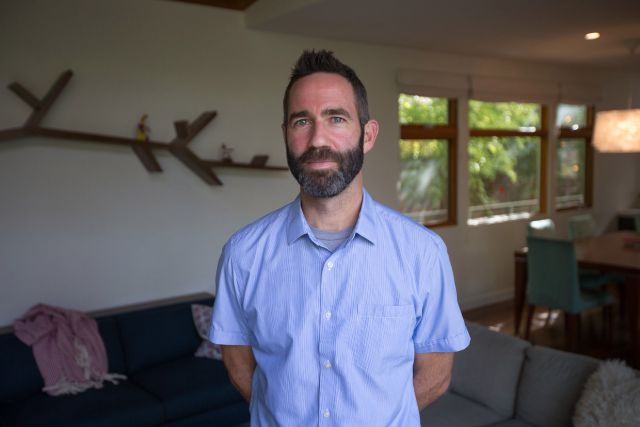
Mark Crady
So, Zipdash joined Google, and his team began working on a product that later turned into a mobile version of Google Maps. And, of course, no one expected that, compared to the online Google Maps (Where2) and Google Earth (Keyhole), the mobile version of the service from the tiny Zipdash will turn into one of the largest projects of the company. In 2009, Crady left Google and is currently working on his new project.
Life at Google
When the three above-mentioned companies became part of Google, their employees continued to work on their products, but within the framework of the vision of their new employer. They were allowed to lure new entrants within the company. For example, the Rasmussen brothers called ... Danish cookies as one of the advantages of working on their team.
So the work has begun. The Where2 team stuffed a bunch of computers into their room that rendered the “tiles” that make up the map. Jens Rasmussen (Jens Rasmussen) proposed the idea of introducing the famous Google pins (pins) as opposed to the red stars in Yahoo Maps. The advantage of this designation option was that the pin with its sharp corner indicated a place on the map, without blocking it with itself. Jens wanted to achieve the effect of three-dimensional pins, although in fact they are not three-dimensional.
At the same time, John Hanke of Keyhole began to carefully work out a request to increase the resolution of satellite images, since it was very expensive. John wanted to start with big cities. Prepared a large presentation on cost structure for Page, Brin and Eric Schmidt. At the end of the presentation, Brin asked, “Why aren’t we just doing all this?” Hanke says he was shocked at that moment, but Brin was serious. Increasing the resolution of images cost Google many millions of dollars, and the company specifically created a high-speed communication channel to receive such volumes of traffic from a supplier from Colorado. But so far, Google’s level of ambition has exceeded the interest shown by users in their service.
Height
Initially, Google Maps and Google Maps Mobile had low traffic. This is even more surprising against the background of their current demand. When the link to Google Maps was placed on Slashdot, the traffic just went through the roof. In these early days, it reached 10 million views.
However, then traffic fell rapidly. And almost a year passed before he again reached the initial level. The development team was sure that their product was the best on the market, and users agreed with them, but for some reason were in no hurry to use the service.
In the end, an unprecedented increase in attendance was achieved thanks to two things. Firstly, satellite images from Keyhole were added to Google Maps, and now anyone could see their house from a bird's eye view. And secondly, the client part was completely rewritten in order to increase productivity, and in addition, a package of tools for developers was released, which allowed third-party companies to use the Google service at the core of their products, thereby promoting it.
Since then, traffic growth has not stopped. By the end of 2006, less than two years after launch, Google Maps had become the largest map service in the world. And soon in terms of traffic, he became the second Google project after www.google.com .
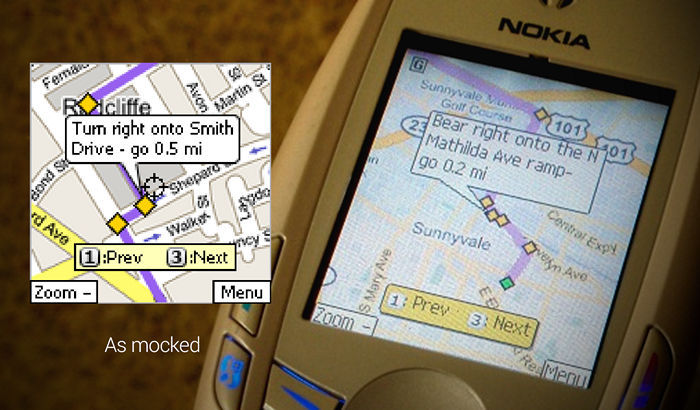
Something similar happened with Google Maps Mobile. The first version was available only for a few phone models and did not allow to see the current congestion of roads. The number of installations was small, and those who installed the program did not use it too much. The situation changed for the better only after support for BlackBerry phones was added.
But even then, there were people on Google who did not see the potential of this project. Of course, this is a long time ago.
In January 2006, Yahoo launcheda product called Yahoo Go, in which many previously scattered services of the company were combined: a search engine, a news resource, an email service, weather forecasts and traffic information. Crady agrees with Schmidt that the development team of the mobile version of GM will create a decent response product. From this day there was only talk about the need to create a completely killer application.
Deal with apple
Today it is obvious to everyone that mobile cards are the most deadly application. Since your smartphone knows where it is, you can go wherever you look, find a place nearby, go around the traffic jam and give a damn about taxi drivers.
And it's not just about Google Maps. Over the past decade, several products of comparable quality and functionality from Baidu, Microsoft, Yahoo and Apple have appeared. But 10 years ago nothing of the kind existed.
The default installation arrangement on all iPhones was a huge fortune for GM. However, the difficult relationship between the two companies began long before Apple launched its mapping service in 2012.
Even before the launch of the first iPhone in 2007, Apple secretly agreed to collaborate with Google. The Yabloko wanted to ship their phones with a preinstalled application, and for this they needed the help of Google. However, Apple did not allow themselves to develop an interface; they agreed to only upload their data. In conditions of the highest secrecy, the companies jointly developed an application for the first Apple smartphone.
From the very beginning, two corporate cultures had little in common. But most of all, Apple was dissatisfied with Google’s work on Android. Jobs began to put forward various demands, including a ban on the use of double tapas for zooming the map. In addition, Apple refused to share statistics on user activity with Google, as a result, the company was forced to generate a road activity map without the participation of a huge proportion of users.
The list of requirements is getting longer. It was originally planned that Google would be the exclusive provider of maps for the iPhone. However, then Apple decided to negotiate to allow third companies. Google again requested user activity statistics, and again was denied.
According to Mark Crady, looking back it becomes clear that even Steve Jobs, despite his incredible instinct, could not predict the future development of mobile cartography. In fairness, I must say that, given such prolonged friction between the companies, Google should have prepared Plan B long ago in case Apple refuses to cooperate. But when this finally happened in 2012, the company was taken by surprise and for three months thought what to do next.
View from the street
In 2007, Google hired a research team from Stanford, which was engaged in three-dimensional scanning of the statue of David by Michelangelo. In addition, VuTool, a startup founded by a professor at the same university, Sebastian Thrun, was acquired. The startup was concerned with the visualization of data captured using external cameras installed on cars. The new employees were combined with those who volunteered to spend their “experimental 20% of the time” on a project that eventually became part of GM - Street View.
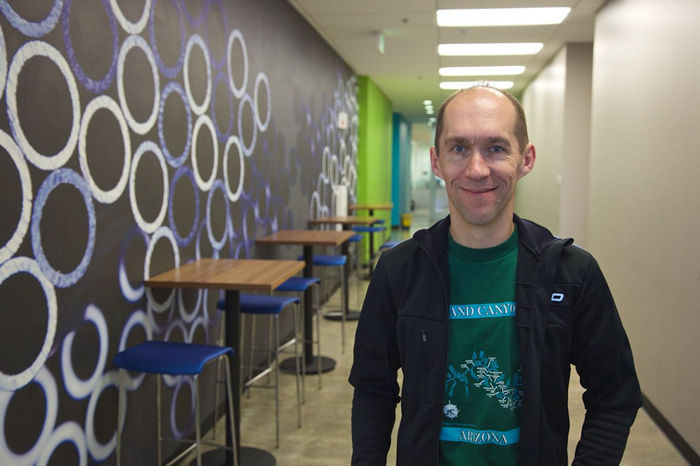
Luc Vincent
One of the “volunteers” was Luke Vincent, Google’s CTO. At that time, he worked for the company for more than ten years and was a member of the Google Books development team. According to Luc, at the beginning of work on Street View, the development team bought several used Chevy Astrovan, approximately $ 5,000 each.

The cars were filled with equipment and cruised through Mountain View and Palo Alto, taking down the streets. We drove very slowly to reduce the effect of vibration. Among other things, the machines were equipped with laser systems, which showed off the bright brand SICK.
No jokes, but thanks to Street View, the Google Maps project was regularly attacked by privacy advocates. Years later, it will be discovered that one of Google’s engineers used Street View machines to intercept Wi-Fi traffic and redirect to Google’s servers. For this, the company has been severely criticized in several countries.
In addition, many people did not want their homes shown on satellite imagery. And now they are also being photographed on the street. Under pressure from the public, Google has introduced the practice of blurring all car numbers and pedestrians in Street View images. And because of the incident with Wi-Fi, the service was banned in several countries, including Germany.
But, nevertheless, Street View withstood all the blows, and now it is available in all versions of Google Maps in 65 countries. Images taken by machines periodically help create and fix GM maps. With machine learning, Google can now display buildings, road signs, traffic patterns, and building numbers very accurately.
Ground truth
The last episode from the Google Maps biography has been kept secret for many years. In 2007, two multi-billion dollar acquisitions took place: TomTom bought Tele Atlas, and Nokia bought Navteq. Unexpectedly for Google, the two largest providers of cartographic information changed their hosts. And not the fact that the new owners will be friendly. The company decided that something needs to be done.
A specially created group of developers began to study what kind of data the new owners may need to create their own map services, who owns such data and, more importantly, who is willing to sell them. In many cases, Google had to analyze the situation at the scale of individual cities. They called it Ground Truth.
During the work of this analytic group, it was possible to find out that the Ground Truth project can help Google not only get rid of archaic license agreements that were once created for CD-ROMs and built-in car navigators, but also develop new services, such as maps of cycling and walking routes.
And Google decided to do it. It was a well-considered decision. If you start creating a map of the world, then you can never stop. After all, the world is constantly changing, and in some cases this becomes a real challenge for the company, because in this business you can’t just try and change your mind.
An international team of 20 specialists worked on the collection of cartographic data. Sebastian Tran led the development of tools and services designed to integrate all types of data. A large group of programmers from India helped in this work.
When the first turn was completed and a map of the USA was created, letters were sent to Google employees asking them to test the map where they live, especially in those places where they grew up.
Epilogue
This ends the early history of Google Maps. Today, many of those who created the main components of this service either do not work on Google, or have switched to other projects. For example, Luc Vincent continues to process images, but this is already data from two satellites that Google received after the acquisition of Skybox for $ 500 million in June 2014.
Today, the geographic information services division is one of Google’s key divisions. The Ground Truth project is still working to keep the company's maps up to date. New third-party companies and startups like Zagat, Waze, and Skybox are being acquired. Street View replenished with pictures of the Grand Canyon and canals of Venice. And Google Maps formed the basis of one of the most ambitious projects of the corporation - robotic cars.
